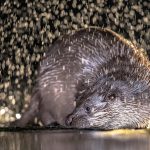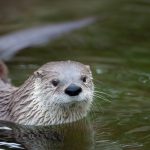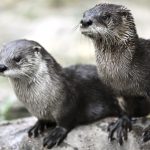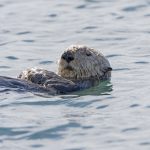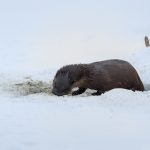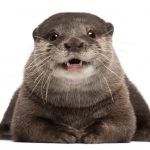Most otters choose to live in inland lakes and rivers and sometimes even live behind a huge dam. However, otters don’t actually build these dams – beavers do.

So, Do Otters Build Dams?
Otters are one of the most aquatic furry mammals on the planet – along with beavers, muskrat and nutria (coypu). All very similar-looking of course – and all very brown in colour – so they are easily confused. They all love swimming in lakes and rivers. so it can be difficult to figure out which one is which.
However, only the beaver actually builds dams. Otters and the others cannot do this – although they may move into an older nesting site in, or around, a previously-owned beaver dam. But how can you tell who is who?
Luckily – there are a few tell-tale signs that help tell them apart – their size – and their tails:
Muskrat – the smallest: about the size of a real rat and with a skinny bald tail to match
Nutria – 1ft long tail: large rodent with a long naked tail held straight while swimming
Beaver – huge rodent (40lb): a noticeable furless paddle-like tail that they slap the water with
Otters – vary in size: long and thin – they swim just under the water and have a fully-furred thick tail
Where Do Otters Live?
Otters are all across the globe – and they vary considerably in where and how they live. There are two main differences in the otter world and they are the following: whether they swim in just the ocean, just rivers or both combined; and whether they only hunt in water or whether they are able to hunt on land too. and depending on the combination of the two things is where you will find them.
The most famous otter species is the Sea Otter (Enhydra lutris) – a giant otter who lives off the Pacific coast of North America. They frequent the coastal areas of Mexico, California and all the way up to Alaska – where some of the highest concentrations are found. Reaching up to 99lbs and over a meter in length – they aren’t hard to see in their coastal habitat. They also have the adorable habit of sleeping on their backs and floating around together in large groups.
Other otters including the Eurasian Otter (Lutra lutra) and North American River Otter (Lontra canadensis) can live along the coast too. They do favour inland rivers in woodland as prime fish-catching habitat though – and they will eat crustaceans and molluscs using their dexterous hands and often wander on dry land to socialise and eat other foods if easy to find.
There are a few species of otters who will only live inland in fresh water and will not go to the sea at all – including the Spotted-necked Otter (Hydrictis maculicollis) from Africa and the well-loved Giant Otter (Pteronura brasiliensis) from the Amazon and Pantanal. Also feeding mainly on fish – they regularly travel overland to seek out new feeding opportunities and waterways.
Are the Methods to Stop Beavers from Building Dams Also Effective for Otters?
When it comes to stopping beavers from building dams, the methods employed may not be as effective for otters. These two species possess distinct behaviors and habitats, resulting in varying approaches needed for managing their dam-building activities. Understanding the unique characteristics and requirements of each animal is paramount for implementing successful conservation strategies.
Are Otters Related To Beavers?
Although otters look quite similar to beavers – and live in the same places – they are not closely related at all. They couldn’t be less related, to be honest. They also have completely different diets, different teeth, and different behaviours – and speak a different (body) language. The only things they have in common are a thick brown coat and a penchant for swimming.
Otters are a member of the mustelid family (including weasels, badgers and wolverines) – who are all carnivores by trade. Otters and minks are the only two main groups who regularly choose to go swimming – but all of them probably could if needed. They usually have elongated bodies and run with a lolloping, rolling gait due to their longer bodies and short legs.
Beavers on the other hand are rodents – and most closely related to kangaroo rats and gophers (although not even that close). They are huge rodents (the second-largest rodent after the capybara) and have giant yellow teeth and a paddle-shaped tail. They really are totally unique in appearance. They are 100% herbivore too – they only eat plant material. Oh, and they build dams!
Just like a lot of other animals who have chosen the same place to make a living (like fish and dolphins: bats and birds) – they look slightly like each other – even though they aren’t close family.

